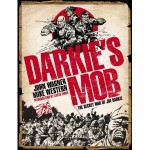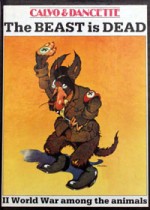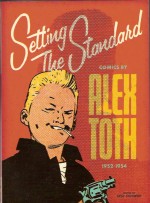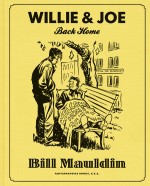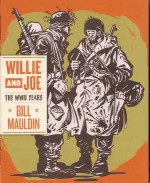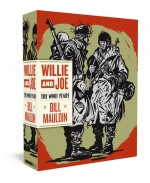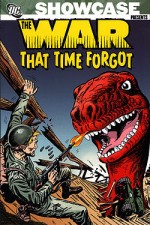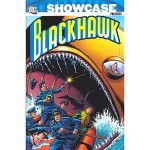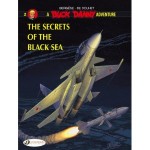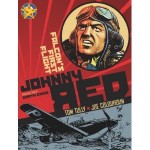
By Tom Tulley & Joe Colquhoun (Titan Books)
ISBN: 978-1-84856-033-8
In acknowledgement of the upcoming Comics in Conflict event at the Imperial War Museum this weekend – see our Noticeboard for details – I’m reviewing another captivating combat classic.
Britons have been enamoured of fighting aviators since the earliest days of popular fiction, but wonderful and thrilling as Biggles, Paddy Payne, I Flew with Braddock or Battler Britton might have been, the true hellish horror of war in the air didn’t really hit home for comics readers until strip veterans Tom Tully and Joe Colquhoun began crafting the epic career of a troublesome working class maverick pilot kicked out of the RAF at our time of greatest need, only to carve a bloody legend for himself in the blistering skies of the Eastern Front.
Johnny Red debuted in January 1977, in #100 of the increasingly radical war comic Battle Picture Weekly and Valiant, swiftly becoming a firm fixture for the next 500-odd issues, before finally calling it a day in 1987. Even then the strip continued as a reprint feature in Best of Battle until Fleetway stopped publishing comics.
Falcon’s First Flight collects chapters 1-37 of the long-running aerial epic in a lavish monochrome hardcover which also features an effusive introduction from starry-eyed fan Garth Ennis and a fascinating historical essay from Jeremy Briggs. Genesis of a Hero provides some intriguing perspective as well as revealing the incredible story of the pilot who was the real life inspiration for Johnny Red.
The racing breakneck action (utterly unavoidable since almost all Battle instalments were between three and four pages long) opens on September 1941 as young Liverpool oik Johnny Redburn helplessly watches Stukas and Junkas strafe and bomb the merchant ship he’s working on. The Empire Cape is part of a relief convoy en route to Murmansk with supplies for Britain’s hard-pressed Russian allies.
Scared and helpless Redburn recalls the incident which got him cashiered from RAF training (originally striking an officer but later retconned into accidentally killing an instructor) and banned from flying. He doesn’t miss the snobs and stupid rules but Johnny was a natural flier and is still hungry for the skies…
Unable to provide fighter escorts or aircraft carriers, the Navy at this time outfitted some freighters with a catapult-launched plane. The Cape has one of these insane contraptions: a single Hurricane which would be launched into enemy-filled skies with a few hours’ fuel and a pilot expected to do whatever he could until German bullets or the seas claimed him. Convoy ships had no landing facility and if the flier survived the dogfights he was expected to ditch in the sea or crash…
When the aviator is killed on the way to launch Johnny takes his place and against all odds shoots down enough attackers to allow the crew of the Cape to successfully abandon ship. Now he faces a unique dilemma. He is an illegal pilot in a stolen plane he can’t land. Having no faith in British military justice or the cold cruel waters below Redburn decides to try for the Russian mainland and a proper landing field…
Typically though, it’s a case of out of the frying pan and into the freezer as lethal weather conditions close in. Miraculously escaping fog, storm and ice he lands in a hidden base only to be mistaken for a German by the starving and desperate air fighters of the 5th Soviet Air Brigade… the “Falconsâ€.
These are patriotic but damned men, ordered to resist to the last in creaky biplanes against the overwhelming forces of the Luftwaffe. As the embattled communists close on Johnny the Germans attack and a unique bond of comradeship is formed as his skill and modern Hurricane wreaks havoc amongst the complacent Nazis.
With nowhere else to go Johnny joins the squadron of the doomed, galvanising them into a competent unit of rule-breaking, triumphant aerial killers risking everything to save their beleaguered homeland.
Ill-supplied and written off by their own leaders the Soviet airmen are convinced by “Johnny Red†to steal whatever food, replacements and weapons they need from their own retreating forces, quickly becoming a cohesive and credible threat to the once unstoppable Germans.
The warrior’s spectacular revival causes its own problems. Johnny is hiding from all contact with the British, convinced that only jail or the gallows awaits him, whilst beyond the close brotherhood of his fellow Falcons, successive Soviet military bureaucrats such as demented political officer Major Alexie Kraskin – a martinet who loves executing his own troops if they won’t obey suicidal orders – or cowardly, carpet-bagging Comrade Colonel Grigor Yaraslov, politically appointed to lead the resurgent squadron, all seem far too eager to get rid of the humiliatingly competent foreign interloper…
In sortie after sortie Johnny Red tackles privation, exhaustion and the enmity of his superiors whilst clearing Russian skies of fascist predators, but as this first volume closes he faces his greatest challenges.
With the Falcons posted to the frozen hell of Leningrad during the worst part of the German siege Johnny is increasingly plagued by the recurring effects of an old head-wound causing sporadic fits of blindness whilst a kill-crazy psychopathic replacement to the Falcons is determined to murder the Englishman, for stopping the strafing of Germans after they have surrendered…
These gritty, evocative tales are packed with historical detail, breathtaking passion and a staggering aura of authenticity. The classic theme of a misfit making good under incredible adversity has never been better depicted and Tom (Kelly’s Eye, Steel Claw, Roy of the Rovers, Raven on the Wing, Harlem Heroes, Mean Arena) Tully’s visceral scripts are perfectly realised by miracle worker Joe Colquhoun. The artist quit writing and drawing Roy of the Rovers to perfect his mastery of aviation war-stories on the long-running but more traditional Paddy Payne in Lion (from 1959 until the feature folded) before co-creating Johnny Red in late 1976. He illustrated 100 episodes before moving on to his greatest work Charley’s War.
This premiere collection is a grand moment in the transition of comics from boy’s own bravado in a Toff’s World to mature, mercurial yet moving adventures starring ordinary working class heroes. Johnny Red was at the forefront of this invasion of extraordinary commoners during a war that almost abolished the class system forever.
However, whatever your dogma or preferred arena of struggle, there’s no question that these magnificent war-stories are among the Few: the cream of British comics well worth your avid time and attention.
Johnny Red © 2010 Egmont UK Ltd. All Rights Reserved. Introduction © 2010 Garth Ennis. Genesis of a Hero © 2010 Jeremy Briggs.

